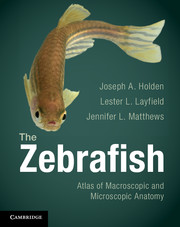Book contents
- Frontmatter
- Contents
- Preface
- Acknowledgments
- Chapter 1 Introduction
- Chapter 2 Cross section and longitudinal section atlas
- Chapter 3 Integument (skin)
- Chapter 4 Digestive system
- Chapter 5 Respiratory system
- Chapter 6 Circulatory system
- Chapter 7 Liver and gallbladder
- Chapter 8 Pancreas
- Chapter 9 Endocrine organs
- Chapter 10 Kidney
- Chapter 11 Reproductive system
- Chapter 12 Sensory systems
- Chapter 13 Central nervous system
- Chapter 14 Miscellaneous structures
- Chapter 15 Musculoskeletal system
- Index
- References
Chapter 13 - Central nervous system
Published online by Cambridge University Press: 05 February 2013
- Frontmatter
- Contents
- Preface
- Acknowledgments
- Chapter 1 Introduction
- Chapter 2 Cross section and longitudinal section atlas
- Chapter 3 Integument (skin)
- Chapter 4 Digestive system
- Chapter 5 Respiratory system
- Chapter 6 Circulatory system
- Chapter 7 Liver and gallbladder
- Chapter 8 Pancreas
- Chapter 9 Endocrine organs
- Chapter 10 Kidney
- Chapter 11 Reproductive system
- Chapter 12 Sensory systems
- Chapter 13 Central nervous system
- Chapter 14 Miscellaneous structures
- Chapter 15 Musculoskeletal system
- Index
- References
Summary
Fishes have low brain to body weight ratios when compared to mammals. The brain is divided into five parts (Figures 13.1 and 13.2) located from anterior to posterior as: (1) telencephalon; (2) diencephalon; (3) mesencephalon; (4) metencephalon; and (5) myelencephalon–3.
Telencephalon
The telencephalon is primarily associated with processing of olfactory stimuli, and the olfactory nerve (cranial nerve I) runs from the nostrils to the telencephalon–4. The most rostral component of the telencephalon is the olfactory bulb. These bulbs communicate with the remainder of the telencephalon by the medial and lateral olfactory tracts. Each olfactory bulb is composed of four laminae that are concentrically arranged. The remaining telencephalon (Figure 13.2) is divided into the ventral and dorsal telencephalic areas each containing a number of nuclei and commisures. Centrally within the telencephalon lies the telencephalic ventricle.
Diencephalon
The diencephalon lies between the forebrain (telencephalon) and the midbrain and is also called the saccus dorsalis. It is involved in control of homeostasis and the endocrine system. The hollow and invaginated pineal body lies dorsal to the diencephalon. The diencephalon has five major divisions arranged in a dorsoventral distribution. These divisions are the epithalamus, dorsal thalamus, ventral thalamus, posterior taberculum, and the hypothalamus (Figure 13.1). These structures enclose the central diencephalon ventricle.
- Type
- Chapter
- Information
- The ZebrafishAtlas of Macroscopic and Microscopic Anatomy, pp. 122 - 129Publisher: Cambridge University PressPrint publication year: 2013



